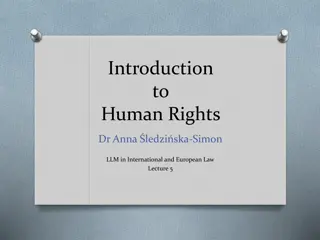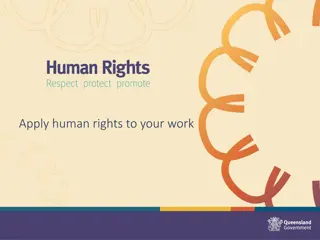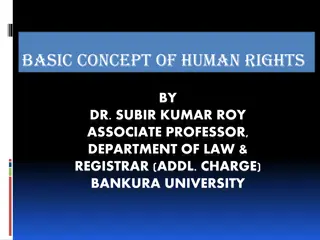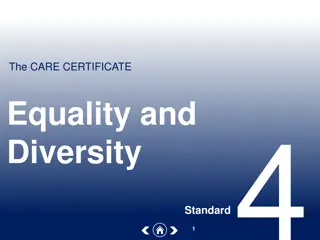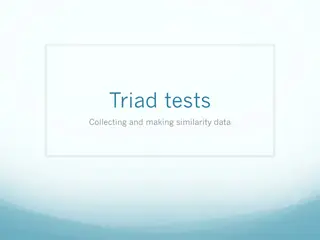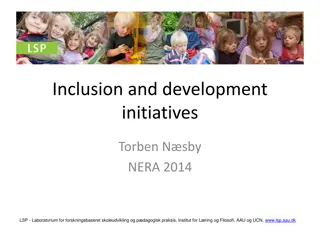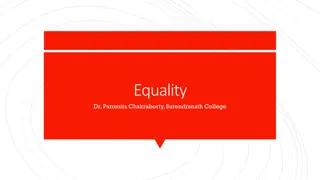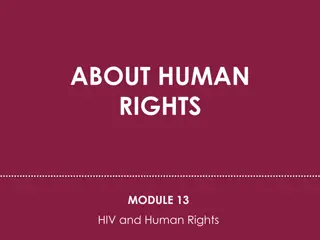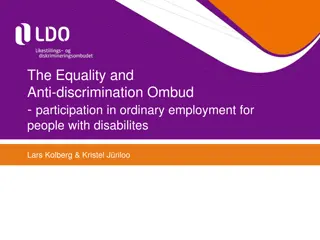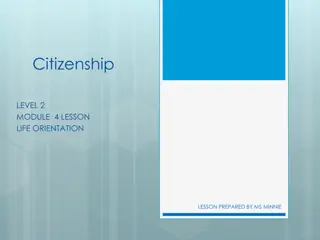Understanding the Triad of Equality, Inclusion, and Human Rights
Human rights ensure basic rights for every individual, promoting values of fairness, dignity, and equality. Equality and inclusion play crucial roles, guaranteeing fair treatment and opportunities regardless of background or beliefs. Embracing diversity is key to eradicating prejudice and discrimination, allowing everyone to thrive beyond stereotypes.
Download Presentation

Please find below an Image/Link to download the presentation.
The content on the website is provided AS IS for your information and personal use only. It may not be sold, licensed, or shared on other websites without obtaining consent from the author. Download presentation by click this link. If you encounter any issues during the download, it is possible that the publisher has removed the file from their server.
E N D
Presentation Transcript
NAME :- SEHAJ SARIN
UNDERSTANDING THE TRIAD OF EQUALITY INCLUSION AND HUMAN RIGHTS
INTRODUCTION:- Human Rights, as the name suggests, are the basic rights which are guaranteed to every person living in the world from birth till death. They are mainly based on values such as fairness, dignity, respect, equality and independence. They also stand for equality, for inclusive societies too, because everyone in this world can claim his/her human rights. Equality and Inclusion, are supported by Human Rights, because everyone in this world has the same right to receive care irrespective of their background or their religious beliefs.
WHAT IS EQUALITY? Equality means the fair treatment, all the people will be treated fairly or equally, no matter what their age, race or sex is or whether they have a disability or not. It ensures that every individual has an equal opportunity. Both of these words, equality and inclusion are related to the areas like gender, race, age, sex, disability and religios beliefs.
WHAT IS INCLUSION? Inclusion means the feeling of being valued. It refers to an experience of an indicidual, in a wider society, and the extent to which they realise and feel that they are included and valued. It is about giving equal opportunities to everyone irrespective of their religion, race, gander, sexual orientation and culture. It is mainly important to understand someone s differences so that you can include them and also treat them fairly and equally.
HOW EQUALITYAND INCLUSION ARE RELATED? Equality, Diversity and Inclusion, all of them ensure fair treatment and opportunity for all. The main aim of all the three is to eradicate prejudice and discrimination on the basis of caste, creed, gender, religion, etc. Embracing the various diversities and providing equality to everyone is the main aim. We all need to promote this and value the talent of everyone beyond these stereotypes, so as everyone can reach their potential, can perform their best, beoynd any prejudice.
WHATARE THE PROTECTED CHARACTERISTICS? 1. Age. 2. Disability. 3. Gender Reassignment. 4. Marriage and Civil Partnership. 5. Pregnancy and Maternity. 6. Race. 7. Religion or belief. 8. Sexual orientation. 9. Sex. According to The EqualityAct 2010, follwing are the legal protected characteristics:-
LAWS THAT SUPPORT EQUALITTYAND INCLUSION AT WORKPLACE IN UK There are a variety of discrimination acts that are there to make ensure that companies are adhering to the minimum standards, and the legislation is wide. In UK, the companies are legally bound to adhere certain practices to ensure that discrimination is eliminated and expectations of equality and inclusion are fulfilled in the workplace, such as:- Equality Act. Human RightsAct. Sex Discrimination Act. Disability Act. Race Relations Act. Workforce Race Equality. All of these laws exist to ensure that recruitment of staff is taken from the widest pools of potential always and everyone is given equal treatment and equal opportunity.
LAWS THAT SUPPORT EQUALITY IN INDIA The Constitution of India contains provisions for the Right To Equality inArticles 14-18. The Preamble of our Constitution also provides for the right to equal status and opportunity to the citizens of India. The Rights To Equality forms the basic structure of the Constitution of India. It is one of the six Fundamental Rights provided to the citizens of India. This Right ensures equality before law and equal protection irrespective of religion, race , caste, etc. Article 14:- ensures equality before law. Article 15:- prohibits discrimination on specific grounds of religion , caste, etc. Article 16:- guarantees equality of opportunity in matters of public employment. Article 17:- abolishes untouchability. Article 18:- abolishes titles, other than a military or academic distinction. Thus, the Supreme Court has said that the Constitution lays down provisions for protective discrimination as alao affirmative action.
WHATARE THE BEHAVIORS THAT WILLSUPPORT EQUALITY, INCLUSION AT THE WORKPLACE? Here are some of the practices that will support equality and inclusion at the workplace :- Be aware of unconscious bias. Promote pay equity. Acknowledge holidays of all cultures. Mix up your teams. Communicate the benefits of diversity. Track progress over times.
BENEFITS OF EQUALITY, INCLUSION AND DIVERSITYAT WORKPLACE ? Businesses or companies can reap rewards when these three are present in the workplace:- Business will become more successful. Employees will be invested, motivated and contended. Customers will receive a diverse service. Staff retention will improve. Quality workers will be attracted. Company s reputation will be enhanced.
HOW WOULD YOU BEST DESCRIBE THE MEANING OF EQUAL OPPORTUNITIES? Equal opportunity means that nobody is marginalised, disadvantaged or limited due to the prejudice or bias. Everyone must be treated equally. To understand this, if we apply this to the job vacancies in a company, then the person who is selected for that position will be the one best suited according to his/her qualifications, knowledge and experience and not on the basis of their religion, sexual orientation, ethnicity or disability.
AIMS OF EQUALITY, DIVERSITYAND INCLUSION To make sure that no one feels left out. To avoid discrimination. To provide equal opportunites to everyone. To respect everyone s culture. To eliminate harassment, victimisation. To ensure fair treatement. To eradicate prejudice and bias.
SURPRISING STATISTICS OF EQUALITYAND DIVERSITY In sept 2015, there were 31.21 million people working in UK. In USA, this figure reaches over 121 million people. In relation to culture and ethnicity, recent statistics also show that:- In 2011, BlackAfrican Women and White and Black Caribbean Men were most likely to be unemployed in UK. In 2010, a report suggested that ethnic minority businesses contribute around 25-32 billion to the UK economy each year. Most law skilled jobs are filled by Pakiatani, BlackAfrican and Bangaldesh men. Only 5.5% of directors in FTSE 100 are from an ethnic minority.
INCLUSION AND DIVERSITY IN INDIA India is a country which comprises of a large number of religions, cultures, ethnicities, languages and much more. But at the same time, India is a secular nation, according to the 42ndamendment of the constitution of india, which was enacted in 1976. India is a secular state, has been one, and will continue to be one for times immemorial. The Constitution grants equality to everyone, equality before law and discrimination is prohibited on the grounds of race, religion, sex, etc. It also allows personal laws, hoever, resulting in a dual system that allows forms of discrimination.
IMPORTANCE OF EQUALITYAND INCLUSION Equality holds much importance as it preserves the dignity of an individual. Dignity means self respect and the respect that an individual deserves from others being a fellow human being. It is an essential and a basic Human Right. Inclusion is equally important as diversity does not exist without inclusion. When people feel included, they feel a sense of belongingness that drives the increased positive performance and results.
CONCLUSION Over the past few years, it seems that the whole world has finally understood the importance of equality, diversity and inclusion. Of course, there are some people who are still afraid of the changes taking place. Human Rights describes how much we expecr to be treated as persons normally without being identified on the basis of our culture, relifion or anything. Human Rights also define thatall the people in this world are entitled to a life of equality, dignity, respect and a life free from any discrimination. We don t need to earn our Human Rights as we are born with it. They are the same for every person.



